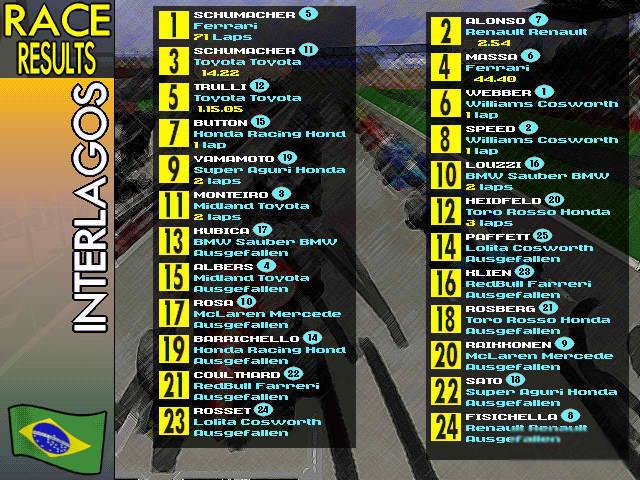Formula One 04 15
четверг 16 апреля admin 73
Sorry for being a day late. Here we go again after my PS2 decided to corrupt all of the data from its memory card. BTW on both channels I will be disabling t. Shop for Formula 10.0.6 at Ulta Beauty.
When it comes to calculating dates in Excel, DATE is the most essential function to understand. As you probably know, Excel does not keep the year, month and day for a date, nor does it explicitly store weekday information in a cell. Instead, Microsoft Excel stores dates as serial numbers and this is the main source of confusion.
Not all Excel date functions can recognize dates entered as text values, therefore it's not recommended to supply dates directly in calculations. Instead, you should use the DATE function to get a serial number representing the date, the number that Excel understands and can operate on.
- Excel DATE formula examples
Excel DATE function syntax
What the Excel DATE function does is return the serial number of a specified date. It has the following arguments:
Year - represents the year of the date. Excel interprets the year argument according to the date system set up on your computer. By default, Microsoft Excel for Windows uses the 1900 system. In this date system:
- If year is between 1900 and 9999 inclusive, exactly that value is used for the year. For example,
=DATE(2015, 12, 31)returns December 31, 2015. - If the year argument is between 0 and 1899 inclusive, Excel calculates the year by adding the specified number to 1900. For example,
=DATE(100, 12, 31)returns December 31, 2000 (1900 + 100). - If year is less than 0 or greater than 9999, a DATE formula will return the #NUM! error.
Month - an integer representing the month of the year, from 1 (January) to 12 (December).
- If month is greater than 12, Excel adds that number to the first month in the specified year. For example,
=DATE(2015, 15, 5)returns the serial number representing March 1, 2016 (January 5, 2015 plus 15 months). - If month is less than 1 (zero or negative value), Excel subtracts the magnitude of that number of months, plus 1, from the first month in the specified year. For example,
=DATE(2015, -5, 1)returns the serial number representing July 1, 2014 (January 1, 2015 minus 6 months).
Day - an integer corresponding to the day of the month, from 1 to 31.
As well as month, the day argument can be supplied as a positive and negative number, and Excel calculates its value based on the same principles as described above.
month or day argument of the Excel DATE function may seem absurd, but in practice it may turn out quite useful, for example in the complex formula that converts a week number to a date.The DATE function is available in all versions of Excel 2013, Excel 2010, Excel 2007, 2003, XP, 2000 as well as in Excel 2016.
Excel DATE formula examples
Below you will find a few examples of using DATE formulas in Excel beginning with the simplest ones.
Example 1. A simple DATE formula to return a serial number for a date
This is the most obvious use of the DATE function in Excel:
=DATE(2015, 5, 20) - returns a serial number corresponding to 20-May-2015.
Instead of specifying the values representing the year, month and day directly in a date formula, you can get some or all arguments as results of other Excel date functions:
=DATE(YEAR(TODAY()), 1, 1) - returns the serial number for the first day of the current year.
=DATE(YEAR(TODAY()), MONTH(TODAY(), 1) - returns the serial number for the first day of the current month in the current year.
Example 2. Excel DATE formula to return a date based on values in other cells
The DATE function is very helpful for calculating dates where the year, month, and day values are stored in other cells. For example:
=DATE(A2, A3, A4) - returns the serial number for the date, taking the values in cells A2, A3 and A4 as the year, month and day arguments, respectively.
Example 3. DATE formula to convert a text string to a date
Another scenario when the Excel DATE function proves useful is when the dates are stored in the format that Microsoft Excel does not recognize, for instance DDMMYYYY. In this case, you can use DATE in liaison with other functions to convert a date stored as a text string into a serial number representing the date:
Vampire hunter d bloodlust gif. Find GIFs with the latest and newest hashtags! Search, discover and share your favorite Vampire Hunter D GIFs. The best GIFs are on GIPHY.
=DATE(RIGHT(A2,4), MID(A2,3,2), LEFT(A2,2))
World of warcraft news. World of Warcraft®: Shadowlands News Round-Up There’s plenty to learn about World of Warcraft’s next expansion, and we’ve rounded up the latest news for you here to help you stay on top of it all. World of Warcraft: Shadowlands introduces a variety of new adventures for players to undertake, including Torghast, Tower of the Damned. Explore its ever-changing halls and chambers and do battle with the minions of the Jailer, Torghast’s vile ruler, to claim legendary treasures and free the heroic spirits trapped within. The largest World of Warcraft (WoW) information site, featuring guides, news, and information on classes, professions, azerite, raids, transmog, and more. There’s plenty to learn about World of Warcraft’s next expansion, and we’ve rounded up the latest news for you here to help you stay on top of it all.
Example 4. Adding and subtracting dates in Excel
As already mentioned, Microsoft Excel stores dates as serial numbers and operates on those numbers in formulas and calculations. That is why when you want to add or subtract some days to/from a given date, you need to convert that date to a serial number first by using the Excel DATE function. For example:
- Adding days to a date:
=DATE(2015, 5, 20) + 15The formula adds 15 days to May 20, 2015 and returns June 4, 2015.
- Subtracting days from a date:
=DATE(2015, 5, 20) - 15The result of the above formula is May 5, 2015, which is May 20, 2015 minus 15 days.
- To subtract a date from today's date:
=TODAY()-DATE(2015,5,20)The formula calculates how many days are between the current date and some other date that you specify.

If you are adding or subtracting two dates that are stored in some cells, then the formula is as simple as =A1+B1 or A1-B1, respectively.
For more information, please see:
Advanced Excel DATE formulas
And here are a few more examples where Excel DATE is used in combination with other functions in more complex formulas:
- How to convert week number to date - the example demonstrates how you can get a date in Excel based on the week number, and also how to get a month corresponding to the week number.
- Find the first day of month - how to get the 1st day of the month by the month number, from a given date and based on today's date.
- Calculate the number of days in a month - how to get the number of days based on the month number or on a date.
- Determine leap and non-leap years - two Date formulas to pin down leap years in Excel.
- Convert a month number to month name - how to change a month number to the month name by using a combination of Excel TEXT and DATE functions.
- Get the day of the year in Excel - this example explains a DATE/YEAR formula to get a day's number.
Using Excel DATE formulas in conditional formatting
In case you want not only to calculate but also highlight dates in your Excel worksheets, then create conditional formatting rules based on DATE formulas.
Supposing you have a list of dates in column A and you want to shade dates that occurred earlier than 1-May-2015 in orange and those that occur after 31-May-2015 in green.
The DATE formulas you want are as follows:
Orange: =$A2<DATE(2015, 5, 1) - highlights dates less than 1-May-2015
Green: =$A2>DATE(2015, 5, 31) - highlights dates greater than 31-May-2015
For the detailed steps and more formula examples, please see How to conditionally format dates in Excel.
How to make date formulas in Excel with Date & Time Wizard
Though DATE is the main function to work with dates in Excel, a handful of other functions are available to tackle more specific tasks. You can find the links to in-depth tutorials at the end of this article.
Meanwhile, I'd like to present you our Date & Time Wizard - a quick and easy way to calculate dates in Excel. The beauty of this tool is that outputs the results as formulas, not values. Thus you have a kind of 'two birds, one stone' opportunity - get the result faster and learn Excel date functions along the way :)
The wizard can perform the following calculations:
- Add years, months, weeks, days, hours, minutes and seconds to the specified date.
- Subtract years, months, weeks, days, hours, minutes and seconds from the specified date.
- Calculate the difference between two dates.
- Get age from the birthdate.
For example, here's how you can add 4 different units in cells B3:E3 to the date in A4. The formula in B4 is built in real-time as you change the conditions:
If you are curious to explore other capabilities of the wizard, feel free to download a 14-day trial version of the Ultimate Suite which includes this as well as 60 more time saving add-ins for Excel.
I thank you for reading and hope to see you on our blog next week!
